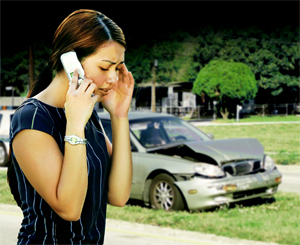Getting into a car accident is a miserable experience; however, when you are involved in a hit and run, that is where things can get especially tricky. According to one report, about one in nine (11%) motor vehicle accidents nationally involves a driver who flees the scene. In Los Angeles, almost half of all crashes (48%) involve a hit-and-run driver. In order to maximize your ability to recover for your losses if you are the victim of a hit-and-run driver, here are a few steps to take:
-
Call the Police:
While you begin to gather information, it is important to call the police to report that you have been involved in a hit and run accident. Although the police may not respond to all non-injury accidents, it should send officers if you notify the dispatcher that the other driver fled the scene.
 2. Gather Information:
2. Gather Information:
The first thing you should look for is the license plate number and the state is was issued in, even if you can only get part of it. If you get a look at the driver, write down a description, including race, gender, clothing, hair color, etc. Recognizing that you will not likely be able to get all this information by yourself, look around for other witnesses. If there are people present who saw the accident, speak to them, but make sure to get their names and contact information so you can call on them later. Also, don’t forget to take pictures of the scene of the accident, including location of the accident, any damage and the area around you.
3. Call Your Insurance Company:
Your insurance company will begin the claims process. Depending upon the type of your insurance coverage, they can immediately help with towing and finding a rental car. If you can identify the driver that hit you and they’re insured, you can likely get their car insurance information from your insurance company and file a claim with the other driver’s company.
In a hit-and-run case, having the minimum car insurance coverage may not offer enough protection to help you in these types of situations. To avoid being held financially responsible for potential repair costs, consider uninsured motorist insurance. This coverage may protect you against drivers who don’t have liability insurance or the money to pay for injuries and damages they cause.
The information in this article was obtained from various sources. This content is offered for educational purposes only and does not represent contractual agreements, nor is it intended to replace manuals or instructions provided by the manufacturer or the advice of a qualified professional. The definitions, terms and coverage in a given policy may be different than those suggested here and such policy will be governed by the language contained therein. No warranty or appropriateness for a specific purpose is expressed or implied.


